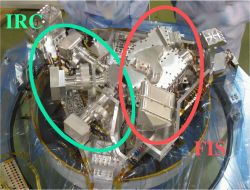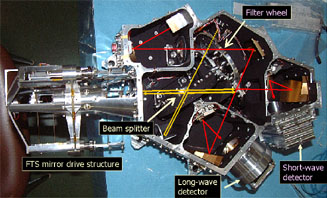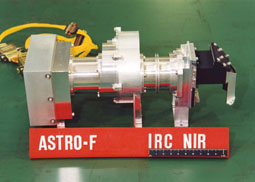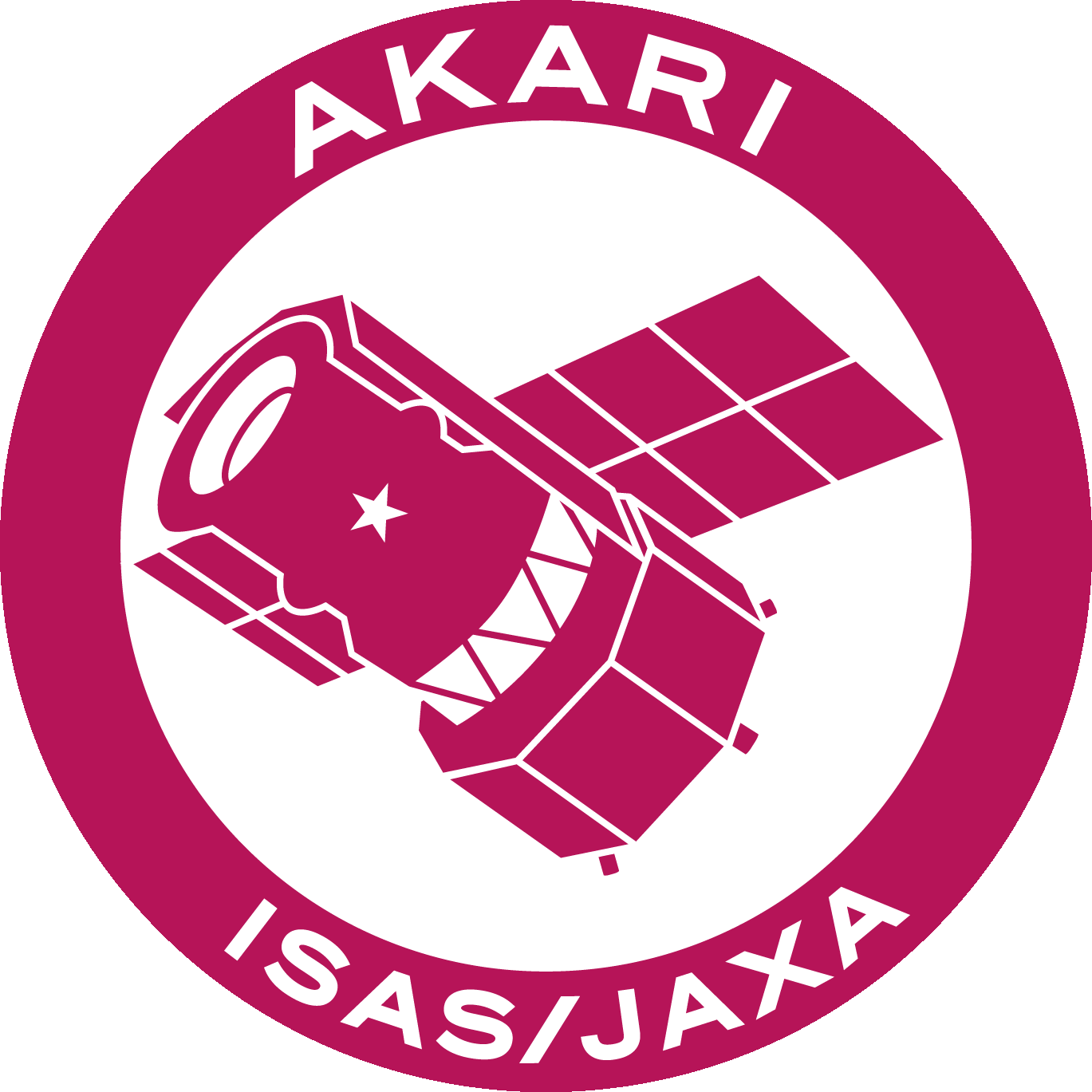Focal Plane Instruments (FPI)

AKARI was equipped with two kinds of instruments; the FIS (Far-Infrared Surveyor) for far-infrared observations and the IRC (InfraRed Camera) for near and mid-infrared observations. The FPI (Focal Plane Instruments) collectively means the FIS and the IRC instruments.
FIS: Far-Infrared Surveyor

The FIS was the instrument chiefly intended to make an all-sky surveyThe AKARI telescope always turned around and swept across the entire sky as it orbited the Earth. at far-infrared wavelengths. Two detectors of the FIS were photoconductors which used semiconductor crystal Ge:Ga, Germanium doped with Gallium. StressedA pressure of 40-60 kgf/mm2 was applied to the detector chips. Ge:Ga chips were sensitive to far-infrared light of longer wavelength than normal ones. Each detector was used with filters. Therefore the FIS had effectively four observation bands.
The FIS was also used for pointing observationsThe telescope was kept toward the same location during an observation. to detect faint objects or to perform spectroscopy using a Fourier transform spectrometer.
Detector SW LW Band Name N60 WIDE-S WIDE-L N160 Wavelength [µm] 50-80 60-110 110-180 140-180 Band Center [µm] 65 90 140 160 Detector Type Ge:Ga Stressed Ge:Ga Array Format 20x2 20x3 15x3 15x2 Pixel Size [arcsec] 26.8 44.2 Pixel Pitch [arcsec] 29.5 49.1 Readout System Capacitive Trans-Impedance Amplifier (CTIA) Sampling Speed [Hz] 25.28 16.86
IRC: InfraRed Camera

The IRC was composed of three independent camera systems. The NIR camera was assigned to near-infrared wavelengths in the 1.7 - 5.5 µmOne micrometer (or micron) is equivalent to one thousandth of a millimeter. range. The MIR-S camera was assigned to shorter mid-infrared wavelengths over the 5.8 - 14.1 µm range and the MIR-L camera was assigned to longer mid-infrared wavelengths of 12.4 - 26.5 µm.
One of the advantages of the IRC was that it was able to observe 10 square arcmin at a time because of large format detector arrays (512x412 for NIR, 256x256 for MIR). Each camera was able to select an specific waveband to observe by using filters. In addition, IRC was equipped with prisms and grismsA grism is an optical component which is a combination of a prism and a diffraction grating. so it was able to perform spectroscopic observations.
The observations of the IRC were basically made in pointing mode. Survey observations using a part of detector arrays were also carried out.
Camera NIR MIR-S MIR-L Wavelength [µm] 1.7-5.5 5.8-14.1 12.4-26.5 Detector Type InSb Si:As Array Format 512x412 256x256 Imaging Area 391x412 233x256 246x256 Imaging Field of View [arcmin] 9.5x10.0 9.1x10.0 10.3x10.2 Pixel FOV [arcsec] 1.46x1.46 2.34x2.34 2.51x2.39

AKARI was equipped with two kinds of instruments; the FIS (Far-Infrared Surveyor) for far-infrared observations and the IRC (InfraRed Camera) for near and mid-infrared observations. The FPI (Focal Plane Instruments) collectively means the FIS and the IRC instruments.
FIS: Far-Infrared Surveyor

The FIS was the instrument chiefly intended to make an all-sky surveyThe AKARI telescope always turned around and swept across the entire sky as it orbited the Earth. at far-infrared wavelengths. Two detectors of the FIS were photoconductors which used semiconductor crystal Ge:Ga, Germanium doped with Gallium. StressedA pressure of 40-60 kgf/mm2 was applied to the detector chips. Ge:Ga chips were sensitive to far-infrared light of longer wavelength than normal ones. Each detector was used with filters. Therefore the FIS had effectively four observation bands.
The FIS was also used for pointing observationsThe telescope was kept toward the same location during an observation. to detect faint objects or to perform spectroscopy using a Fourier transform spectrometer.
| Detector | SW | LW | ||
|---|---|---|---|---|
| Band Name | N60 | WIDE-S | WIDE-L | N160 |
| Wavelength [µm] | 50-80 | 60-110 | 110-180 | 140-180 |
| Band Center [µm] | 65 | 90 | 140 | 160 |
| Detector Type | Ge:Ga | Stressed Ge:Ga | ||
| Array Format | 20x2 | 20x3 | 15x3 | 15x2 |
| Pixel Size [arcsec] | 26.8 | 44.2 | ||
| Pixel Pitch [arcsec] | 29.5 | 49.1 | ||
| Readout System | Capacitive Trans-Impedance Amplifier (CTIA) | |||
| Sampling Speed [Hz] | 25.28 | 16.86 | ||
IRC: InfraRed Camera

The IRC was composed of three independent camera systems. The NIR camera was assigned to near-infrared wavelengths in the 1.7 - 5.5 µmOne micrometer (or micron) is equivalent to one thousandth of a millimeter. range. The MIR-S camera was assigned to shorter mid-infrared wavelengths over the 5.8 - 14.1 µm range and the MIR-L camera was assigned to longer mid-infrared wavelengths of 12.4 - 26.5 µm.
One of the advantages of the IRC was that it was able to observe 10 square arcmin at a time because of large format detector arrays (512x412 for NIR, 256x256 for MIR). Each camera was able to select an specific waveband to observe by using filters. In addition, IRC was equipped with prisms and grismsA grism is an optical component which is a combination of a prism and a diffraction grating. so it was able to perform spectroscopic observations.
The observations of the IRC were basically made in pointing mode. Survey observations using a part of detector arrays were also carried out.
| Camera | NIR | MIR-S | MIR-L |
|---|---|---|---|
| Wavelength [µm] | 1.7-5.5 | 5.8-14.1 | 12.4-26.5 |
| Detector Type | InSb | Si:As | |
| Array Format | 512x412 | 256x256 | |
| Imaging Area | 391x412 | 233x256 | 246x256 |
| Imaging Field of View [arcmin] | 9.5x10.0 | 9.1x10.0 | 10.3x10.2 |
| Pixel FOV [arcsec] | 1.46x1.46 | 2.34x2.34 | 2.51x2.39 |





